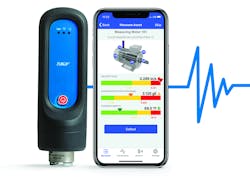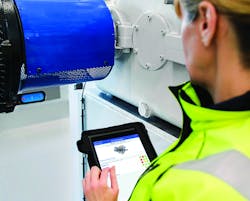Rotating equipment is used extensively throughout processing industries. Regardless of the industry, having equipment operating at peak performance allows manufacturers to maximize throughput and increase profitability. Most plants use some type of reliability or predictive maintenance program to monitor and analyze machine health. However, many companies fail to effectively leverage the collected data to help improve equipment performance and overall plant productivity.
The cost of reactive maintenance
Unplanned maintenance can be seven to 10 times more expensive than planned maintenance. Factors such as rush orders for parts, employee overtime and unplanned production downtime can translate into thousands, sometimes millions, of dollars in losses. This can throw off budget projections and have a negative impact on a company’s business objectives. Unplanned downtime can also affect plant safety. For example, in the oil and gas industry most accidents occur during shutdowns and restarts. When those incidents happen in an unplanned way, the chance for accidents increases.
Fortunately, traditional reliability programs are evolving. Manufacturers are realizing the need to move away from data silos and embrace new technologies to provide actionable insights that help them make faster, more informed business decisions.
Internet of things and connected devices
As the internet of things (IoT) continues to evolve, connected devices that use cloud computing become the work horses for a successful predictive maintenance program. These devices allow plant personnel to access formerly siloed data for a clearer, more holistic view of asset health.
Having the ability to cross-functionally compare things like vibration, temperature and oil analysis allows operators to get an overall snapshot of machine health. These analytics can deliver actionable information for quick and strategic decision-making. Connecting, collecting and correlating data provides a new way for people to interface with machines to increase efficiency and productivity.
This new level of connectivity is ideal for many processing industries. For the food processing industry, there are countless diverse and difficult operating conditions. Extreme temperatures and moisture create contamination-prone environments, while frequent washdowns can degrade equipment and may cause lubricant leakage. Connected devices allow data from these machines to be collected and stored for trending and analysis. By using these analytics, operators can proactively prevent issues that may lead to recalls or other U.S. Food and Drug Administration (FDA) violations.
SKF Pulse portable sensor and mobile app predicts machinery issues before operations are impacted.
Creating a digital roadmap
The road to a successful predictive maintenance program begins by assessing the plant’s daily workflow with industry benchmarks and best practices. A roadmap for improvement is then created based on established business goals and budgetary requirements. Most companies may be challenged to move all their machine assets to the cloud at one time, while others may be able to prioritize critical assets to connect first, then add others as budgets and infrastructure allow.
More importantly, once the roadmap is established, it’s important to develop a master plan for what to do with the data that’s being collected. The goal of a reliability program utilizing connected devices should be to gain insight into asset behavior so the plant can move from reactive maintenance to predicting failure to prevention. The ultimate goal being to dramatically improve reliability and performance.
When using connected devices to collect machine data, plant personnel create profiles for each asset that include standard or customized alarm thresholds based on the asset data provided. The better the data provided, the better the analytics and machine insights. This data allows analysts to monitor and detect issues related to vibration, temperature and lubrication. Having the ability to routinely monitor machine health and receive fast analysis and recommended corrective actions allows the plant to make necessary repairs in a planned way before operations are impacted.
Managing big data decisions
Data analysis can reduce or eliminate machine failure to lessen unplanned downtime and improve profitability. But it can also help prevent failures from happening again through component upgrades, design modifications or changes in servicing.
Many companies — particularly those in the processing industry — lack the time, training or expertise to diagnose machine condition. Smart, connected devices allow plant personnel to collect asset data in order to identify machine health. If alarms indicate a potential issue, the data can be sent via the cloud for analysis by rotating equipment performance experts as part of a predictive maintenance program. This analysis can provide machine insights and recommended corrective actions — allowing plants to focus on their core competencies.
Manufacturers can also opt for pay-for-performance contracts where third-party vendors manage the rotating equipment at their facilities. On-site technicians can interpret the data and make recommendations to ensure optimal performance.
The SKF Pulse sensor acts as a smart vibration tool to quickly and easily identify machine condition and share machine health data.
Solving challenges of the processing industry
Leveraging big data through connected devices can help mitigate some of the daily challenges in processing plants. For example, the dairy industry requires complex processing, filling and packaging techniques. Regular exposure to moisture and cleaning agents leads to lubricant loss in bearings and chains. Machine data acquired via connected devices can help ensure lubricant levels are at optimal levels to avoid premature failure.
In addition, bakery and confectionery production lines are composed of mass-production machinery, which can result in high-product losses and significant time for re-startup. Since rotating equipment is often exposed to extreme temperatures and moisture, having a condition monitoring plan with cloud connectivity can help keep operations up and running.
Connected devices and Industry 4.0
Digitalization brings greater interconnectivity between machines and devices and the ever-increasing use of big data. Industry 4.0 is pushing manufacturers to use data strategically to streamline processes, boost efficiency and significantly improve productivity. The gains from these measures include improved control, transparency, speed, productivity, modularity, availability, safety and sustainability.
Connected devices are the first step on the journey to improved rotating equipment performance, helping manufacturers reduce costs, increase output and comply with legislation. Manufacturers gain powerful operational insights from the data analysis and corrective actions provided by these devices.
Jim Henry is Strategic Marketing – Rotating Equipment Performance and Digitization at SKF USA Inc. Henry has been a Certified Maintenance and Reliability Professional (CMRP) through the Society of Maintenance and Reliability Professionals (SMRP) organization since 2002 and is Level 1 certified in risk-based inspection (RBI) through the Tischuk International organization. He has been developing and delivering solutions to industrial maintenance organizations globally for more than 25 years. Past project experience includes inventory optimization, repairable asset control, Enterprise Asset Management software applications, best practice benchmarking, as well as equipment and business process optimization consulting services for increasing reliability and improving business results. Currently, Henry is involved in the transformation of SKF traditional transactional business models to digital connection models to provide valuable insights allowing for significant operational and financial improvement for SKF customers.





